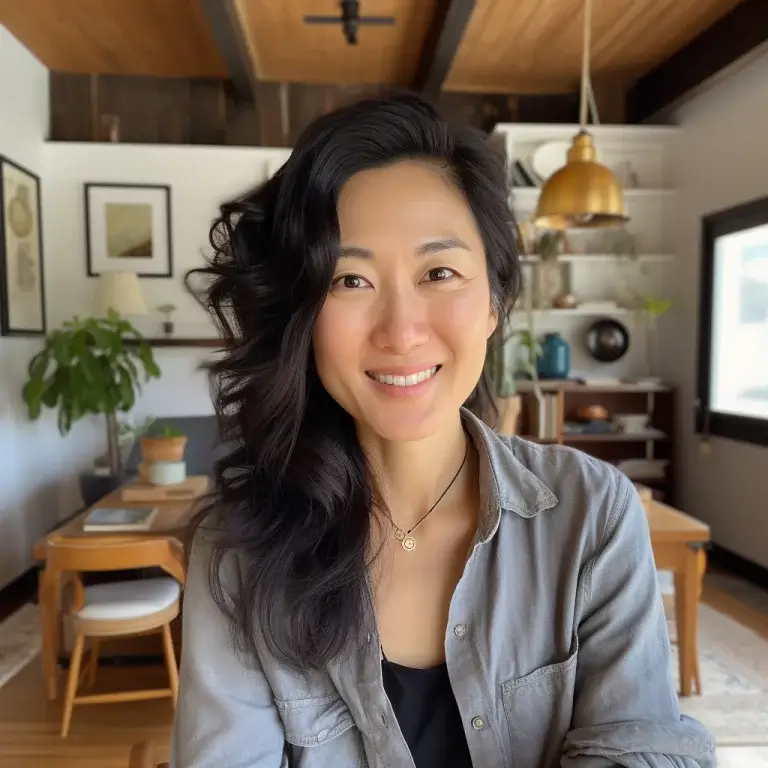Is your commercial roof failing?
I see it all the time – building owners stuck with leaky roofs, costly repairs, and no idea which roofing system will actually last. Flat roof options seem endless, and making the wrong choice can drain your bank account for years.
BUR roofing (Built-Up Roofing) might be your answer. This system has been used since the 1800s and still remains a top choice for commercial buildings today.
The secret? Multiple layers of asphalt and felt create a shield that withstands harsh weather, UV rays, and the passage of time.
In this guide, I’ll show you exactly how BUR systems work, why they last so long, and how to tell if one is right for your building.
What is BUR Roofing?
BUR roofing stands for Built-Up Roofing, a system that has been in use since the mid-1800s. This type of roof consists of several layers of asphalt applied between ply sheets (or felts) over a roof deck and insulation. BUR systems work well for flat or low-slope roofs, making them a top choice for commercial buildings.
The key feature of a BUR roof is its multiple layers. These layers create a strong, water-resistant surface that shields buildings from harsh weather conditions. The basic structure includes:
- Base sheet over insulation
- Multiple layers of asphalt and ply sheets
- A top layer often finished with gravel, slag, or a cap sheet
These multiple plies give BUR roofs their famous toughness and lasting power. The system has stood the test of time for good reason.
The History of BUR Roofing Systems
BUR roofing has a rich history dating back to the 1800s. It was the first “flat” roof type used in construction. The old image of a worker with a mop spreading black tar brings back fond memories for many in the roofing field.
In the early days, these systems used basic tar and paper. Over time, the materials improved – from simple tar to more advanced asphalts, and from paper to felt. These improvements made BUR systems much more effective.
The structure of BUR systems hasn’t changed much over time. What has changed are the materials and methods used. Today’s BUR roofs utilize high-quality felts and asphalt, which offer significantly better protection than their early counterparts.
Components of a BUR Roof System
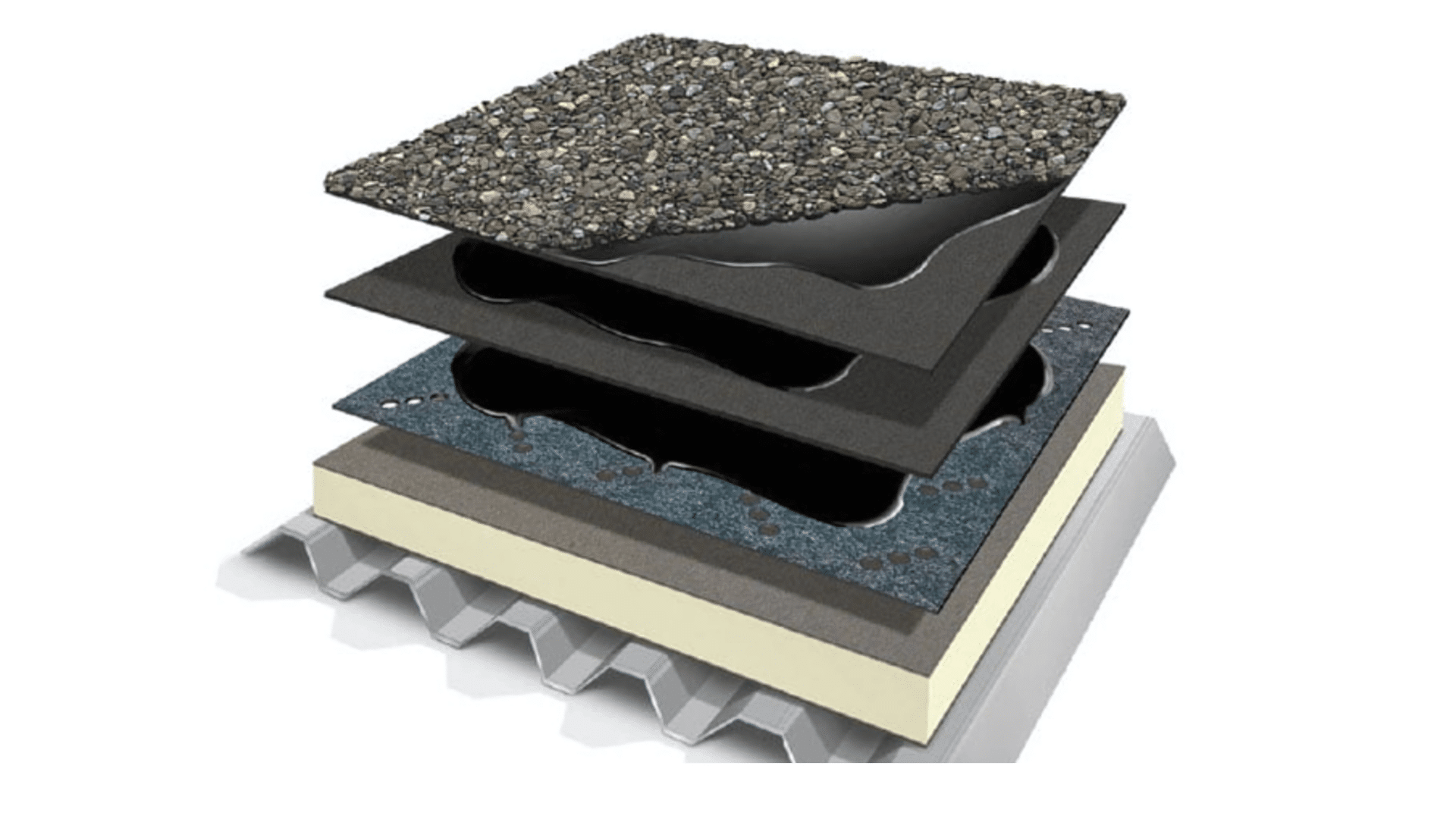
A typical BUR roof system has several key parts that work together:
1. Base Sheet: This first layer is placed over the insulation and is often secured with mechanical fasteners. It forms the bottom layer of waterproofing and provides a surface for other sheets to stick to.
2. Ply Sheets: These reinforcing felts create added barriers against water when soaked in asphalt or adhesive. Multiple plies are added until the desired thickness is reached.
3. Asphalt or Adhesive: This binds the layers together. While hot asphalt has been the standard, cold-applied adhesives now offer an alternative.
4. Top Surface: The system is finished with either:
- A mineral-surfaced cap sheet
- A flood coat of asphalt covered with gravel or slag
The number of plies can vary based on the building’s needs and budget. A standard system might use four plies, but this can change based on local climate, building use, and other factors.
Benefits of BUR Roofing
BUR roofing systems offer many benefits that have kept them popular for over a century:
| Feature | Description |
|---|---|
| Proven Technology | With over 100 years of use, BUR roofs have proven their worth. Their track record speaks for itself. |
| Multiple Layers of Protection | The layered design means that if the top layer gets damaged, the layers below still prevent water from entering. This built-in backup system gives building owners peace of mind. |
| Long Lifespan | A well-built BUR roof can last 20 years or more with proper care. Some experts note that each additional layer may add approximately five years to the roof’s lifespan. |
| Warranty Options | Many BUR systems can come with warranties of up to 20 years, depending on the materials and installation. This gives building owners long-term security. |
| Reflective Options | White-coated cap sheets can reflect the sun’s heat away from the building, potentially helping to lower indoor temperatures. |
| Cost-Effective Over Time | Although the initial cost ranges between $4 and $7 per square foot, the long life and low maintenance needs make BUR roofs a smart long-term investment. |
Is a BUR Roof Right for Your Building?
BUR roofing works well for many commercial buildings, but consider these factors:
- Building Structure: The multiple layers make BUR roofs heavy. Your building must be able to support this weight.
- Installation Expertise: The layering process requires skilled workers with experience in BUR systems.
- Climate Considerations: While BUR roofs work in many climates, local weather patterns might affect which roofing system is best.
- Long-Term Plans: If you plan to keep the building for many years, the durability of a BUR roof makes it a smart choice.
Common Challenges with BUR Roof Systems
Despite their strengths, BUR roofs face some issues that owners should know about:
1. Ponding Water
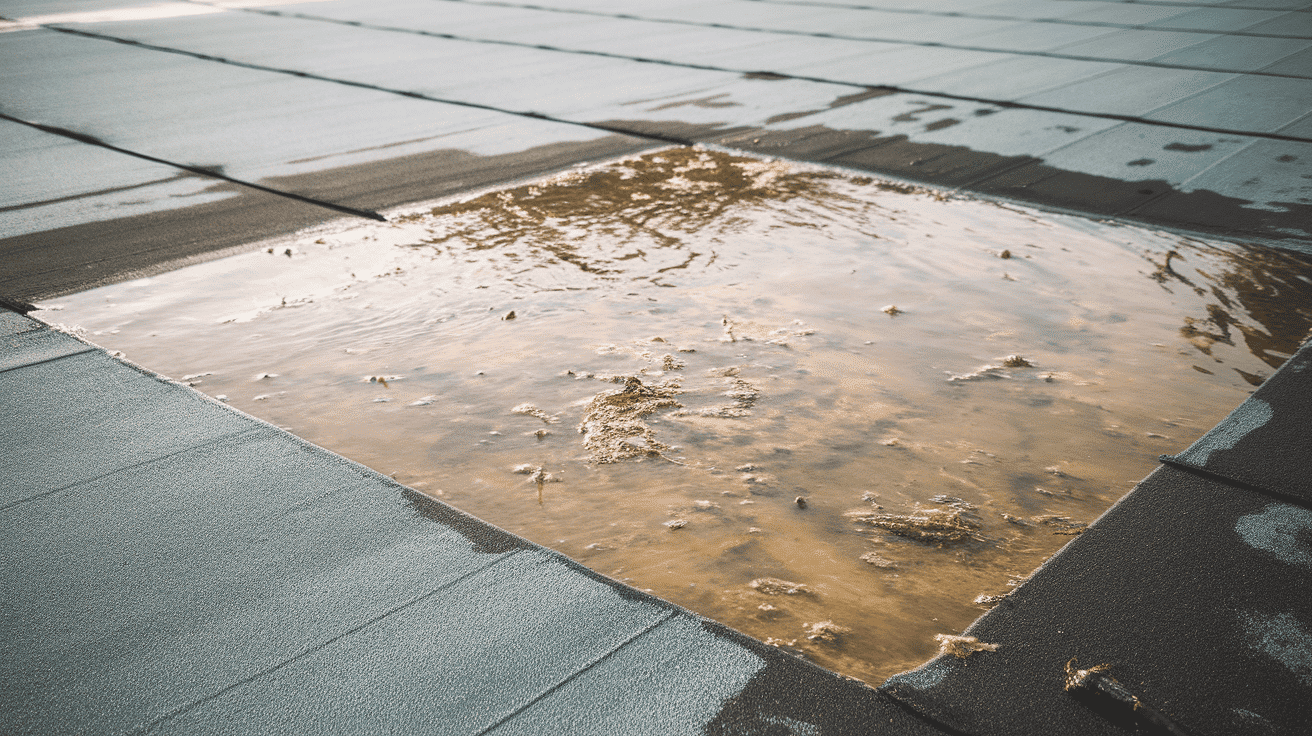
Water that stays on a roof for more than 48 hours creates a “ponding area.” A pond of water just 1 inch deep covering a 10′ x 10′ area weighs 520 pounds! This extra weight can make a roof sag, which then creates a lower spot that collects even more water.
The longer water sits in these areas, the faster it breaks down. The water brings dirt and other harmful stuff that speeds up damage. On average, still water evaporates at about ¼” per day.
2. HVAC Equipment Issues
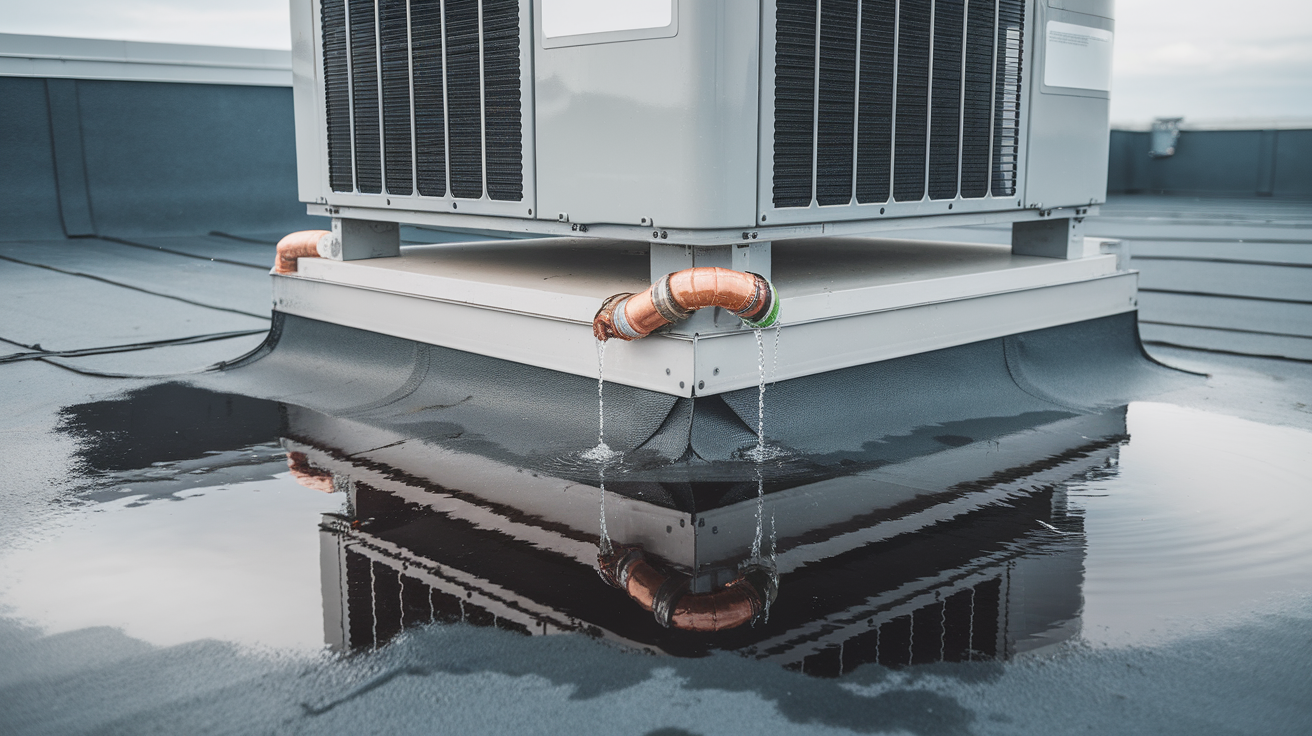
Air conditioning units on the roof can cause problems in two ways:
- Weight: The heavy units can press down on the roof, creating low spots where water collects.
- Condensation: HVAC units create water as they work. If the drainage pipes aren’t secured well, water leaks around the equipment. This constant moisture won’t dry properly and can damage the roof.
3. Penetrations and Vent Pipes
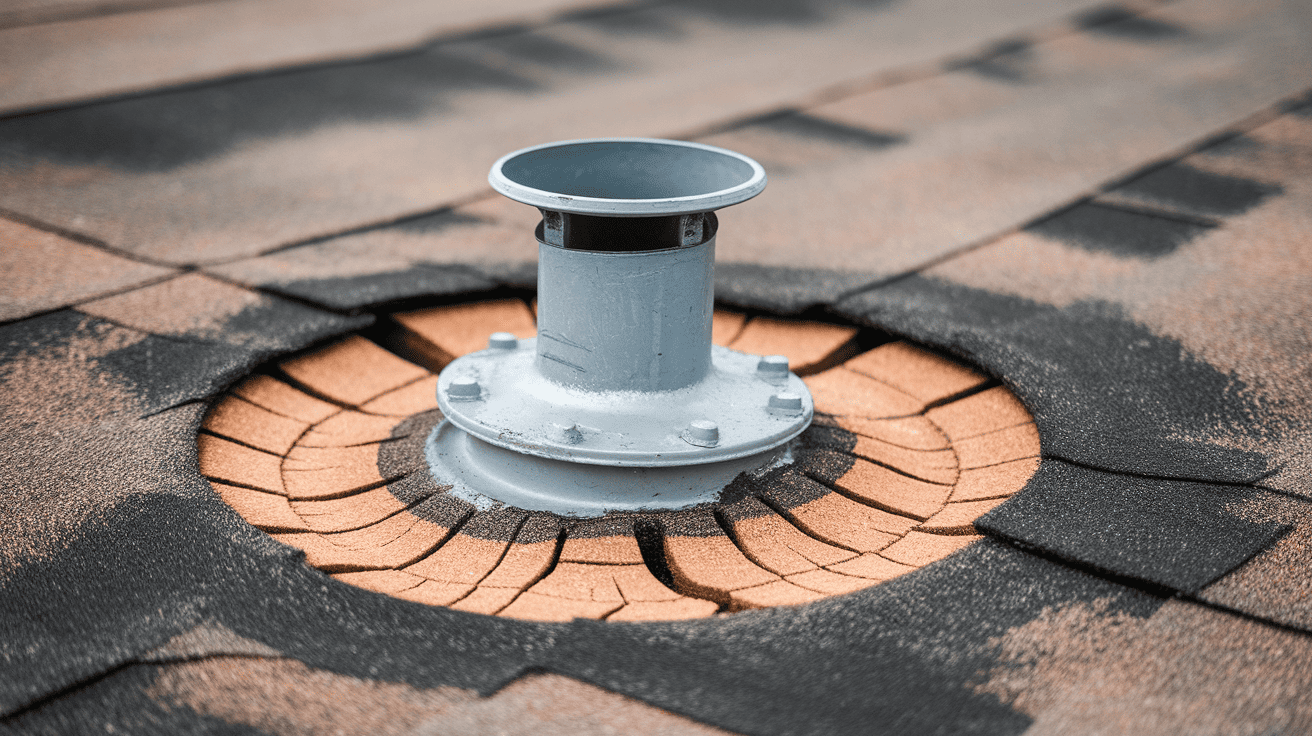
Buildings need vents for bathrooms, kitchens, and other spaces. These openings create weak points in the roofing material.
The issue comes from different materials reacting to temperature changes. Metal pipes expand and contract at different rates than asphalt. This can cause cracks around the joints. If not checked and fixed, these cracks allow water to leak into the building.
How to Protect Your BUR Roof System
Taking care of a BUR roof extends its life and prevents costly repairs:
1. Fixing Ponding Areas
- Clean off all dirt and buildup from these spots
- Make sure the area is completely dry
- Apply proper materials to resist breakdowns in these areas
2. Managing HVAC Issues
Leaking equipment is a maintenance issue that most roof warranties don’t cover. Regular checks of condensation pipes and drain connections can prevent these problems.
3. Securing Penetrations
Roof openings like vents and drains often crack faster than other areas. These spots need regular inspection during maintenance visits. Small issues can be easily fixed when caught early.
Conclusion
BUR roofing offers a time-tested solution for commercial buildings with flat or low-slope roofs. Its multiple layers provide excellent protection that has proven itself for more than a century.
From its simple but effective design to its long lifespan, a BUR roof gives building owners a reliable, low-maintenance option. The initial cost is offset by years of worry-free service when properly installed and maintained.
For business owners looking at roofing options, BUR should be on your short list. Its track record, durability, and widespread use by many roofers make it a worthy choice for your building. What roofing challenges does your commercial building face? Share your thoughts in the comments below.
Frequently Asked Questions
How Long Does a Bur Roof Typically Last?
A quality BUR roof lasts about 20-25 years. With good care and extra layers, you might get 30+ years of use from this time-tested system.
Can Bur Roofing Be Used on Any Building?
BUR fits flat or low-slope roofs only. Your building must have enough structural strength to hold its weight, which can be quite heavy.
How Often Should a Bur Roof Be Inspected?
Check your BUR roof twice a year – once in spring and again in fall. Add extra checks after big storms when damage is most likely.
What are the Signs that a Bur Roof Needs Repair?
Watch for bubbles, cracks, or splits in the surface. Standing water, indoor leaks, and visible felt layers all signal it’s time for fixes.


